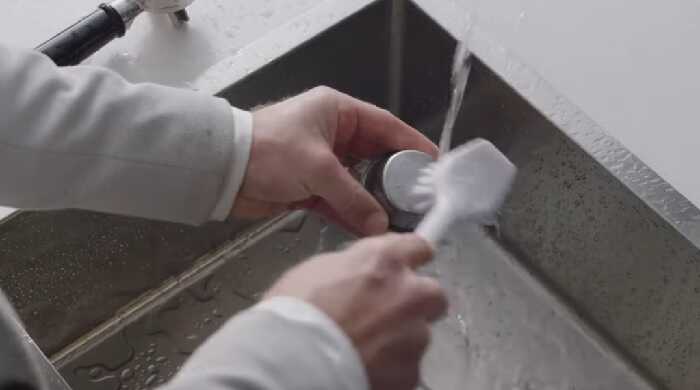Having a Breville espresso machine at home is a necessity for those interested in espresso. Still, not all of them know how to maintain the device since the process might be overwhelming. For this reason, I have prepared a comprehensive guide on how to clean Breville espresso machine for you to follow and take care of your beloved gadget.
Contents
Importance Of Cleaning Your Espresso Machine

Regular cleaning your coffee maker is crucial for the appliance well-being and preserving the flavor of your daily brew. An unclean machine can also affect your coffee texture, giving it an unpleasant bitterness.
Or even worse, the water storage compartment can contain concealed yeast and mold due to improper daily cleaning. Best shots of coffee require the most high-quality water, indeed.
Furthermore, cleaning your device frequently and correctly will extend its lifespan. In the long term, it will help you conserve energy and save your machine from pricey repairs or replacements.
Required Tools For Breville Espresso Machine Cleaning

Before learning how to clean an espresso machine, you will need to prepare the following required tools in order to give your machines a thorough cleaning.
- Cleaning brush: Used for your espresso machine to stay spick-and-span and operate correctly.
- Pin cleaning tool: Used to unclog the orifice if the steam is obstructed.
- Cleaning/descaling tablets: The brewing units need the cleaning tablets, while the water system needs the descaling agent. They will remove all the residual coffee oils in your machine.
- Cleaning disc: A piece of flexible rubber that can fit into the portafilter, often utilized with cleaning tablets.
- Allen key: Use to tighten or loosen bolts.
- Nylon Scrub brush: Suitable for rough scrubbing, surface cleaning or finishing cleaning, dusting, and contaminant removal.
- Container: Utilized for collecting spilled liquid.
- Clean, soft cloth: To clean the coffee machine’s surface.
How To Clean Breville Espresso Machine For Everyday Maintenance

Parts To Clean
Drip Tray
A drip tray is placed under your coffee machine or air pots to collect the runoff during the brewing cycle. It aids in minimizing additional work and keeping your countertop tidy.
Steam Wand
A steam wand is a thin, protruding pipe that is internally attached to the machine’s boiler and protrudes from one end close to the coffee group head or showerhead. It infuses milk with steam to produce a hot, frothy texture for lattes and other hand-crafted beverages.
Coffee Grind Bin
A coffee grind bin, or a knockbox, is a container used to save the puck of leftover grounds after a shot has been withdrawn. It is often constructed of plastic or stainless steel and features a robust bar called a bash bar, which you can tap against a portafilter to remove the puck.
Filter Basket
A filter basket is a metal filter with a basket-like design that contains the coffee grinds when making espresso. Tiny perforations in the basket allow the liquid to travel through while keeping the residual coffee grounds in place.
Cleaning Process
Step 1: After each usage, examine the drip tray and dispose of it in the trash. This part needs to be cleaned every day. Wait until the drip tray is dry before reinstalling it in the appliance. To prevent unpleasant smell or mold growth, give it a thorough wash or a scrub.

Step 2: Drain any milk residues by utilizing it within the steam area till the liquid flows out. Once it has cooled, thoroughly wipe the wand exterior with a clean, soft towel to remove any splashback. Use a pin cleaning tool to fix any jamming problems.

Step 3: Empty your filter basket. Then, wash it with a mixture of water and soap.

How To Clean Breville Espresso Machine For Deep Cleaning Sessions

Parts To Clean
Group Head
Every espresso machine has a group head. It is the device’s brain and produces a superb cup of espresso. The group head, made of metal and permanently connected to the machine, is where the water exits the device and enters the filter basket.
Water Filter
The water filter has an activated carbon filter to lessen the water’s TH (total hardness) while removing chlorine and sediment. If these components aren’t removed from the water, your coffee maker could quickly experience issues, such as scale build-up, jammed pipe fittings, etc.
Grinder
A grinder is a vital built-in tool in your espresso machine for pulling out all the essential bouquet and flavor of coffee beans, supporting the brewing of premium cups of joe.
With integrated grinders, simply place your coffee beans inside the compartment, choose a setting, and let the machine handle the grinding and water brewing for you. Both flat and conical burr grinders have many crooks and crannies to sanitize, so pay close attention to details.
Cleaning Process
Step 1: Remove your machine’s group head. Run a cycle with your portafilter inserted utilizing only water. Observe the water exiting your machine. The water should be as clean as possible since coffee-colored water symbolizes residual coffee in the group head.

Step 2: After completing a water brew cycle, use the pin tool to clean the filter’s holes. Your espresso will taste much better if you clean the filter and discard any old coffee.
Step 3: Change your water filter if needed. Keep in mind to change a new filter every 1.5 to 2 months. Otherwise, your espresso may taste different and, in certain situations, become unsafe to consume.

Step 4: Suppose your espresso machine has a grinder; ensure to clean it when you perform deep cleaning tasks. Keep in mind to never use water or soap to clean your burrs because doing so will make them rust. Brushing it off will do the work to keep it clean and operate smoothly.
Step 5: Use the cleaning tablets and disc to run your Breville cleaning cycle. Wait a couple of minutes for the process to complete.
Step 6: Place another cleaning tablet in your filter by inserting it into the cleaning disc’s center. The portafilter should be connected to the device to make a shot of espresso. Hit and hold the power button, one- and two-cup buttons simultaneously to begin cleaning. The cleaning light will blink after a few seconds.

Step 7: Once it is over, run another rinse cycle using only water to eliminate any cleaning solution that could have lingered in the device. If not, the taste of your subsequent few shots may be off.
Bonus: In case you are still confused about the process, check out this video for more visual guidance.
How To Descale Breville Espresso Machine

With Vinegar
Cleaning experts have traditionally used vinegar to remove mineral deposits and limescale from kitchens and kettles. Mix water and vinegar in a 1:1 ratio, add it to the water tank, and run a couple of cycles for a complete descaling cycle. Remember to do a few more cycles with clean water before preparing coffee to avoid the vinegary aftertaste.
With Espresso Cleaning Tablets
Using tablets makes your descaling process considerably simpler since they are specifically designed for this task. All you have to do is to insert Breville cleaning tablets into your cleaning disc and initiate a cycle.
With Descaling Liquid Or Powder
Similar to vinegar, you put liquid or powder descaling solution into the water tank, let it dissolve, and then activate the machine cleaning cycle. You can choose between liquid and powder solutions based on your preference and budget.
The former is considered the more convenient and more effective. Meanwhile, the latter may result in blockage when it’s not fully dissolved, but it is the more economical option.
Frequently Asked Questions
Why Is My Machine Not Working?
Several reasons can cause your Breville espresso machine to malfunction. Here are a few of the most common ones.
- The machine’s power switch or power cord has failed.
- The valve may have been shut off as a result of clogging.
If you encounter these problems, call a professional to get them fixed. Avoid attempting to fix things yourself since improper repair or replacement could put your safety at risk.
Does Descaling Solution Work Better Than Vinegar?
Vinegar and descaling chemical treatments are equally effective regarding descaling. Users sometimes blame white vinegar for leaving a weird aftertaste, yet it is still praised as the optimal way to get rid of limescale.
Should you not like the smell of the vinegar solution, then you can stick with a descaling solution. On the other hand, vinegar is cheaper, making it the preferable choice for those with tight budgets.
Does Vinegar Damage Espresso Machine?
Vinegar can damage your espresso machine when you misuse it. In particular, the seals and rubber gaskets are vulnerable to vinegar harm. Thus, be cautious in the mixture-making process. It would be best to mix vinegar and water with a 1:1 ratio to avoid any potential damage.
Wrapping Up
Now you know how to clean Breville espresso machine properly after reading this post. It’s critical to thoroughly clean your espresso machine on a regular basis to maintain both hygiene and the equipment’s functionality.
Suppose you are a newbie in the coffee-lover community who’s searching for a new espresso machine; check out my list of the best espresso machines for beginners. It will help you pick the most suitable device for your needs. ()

